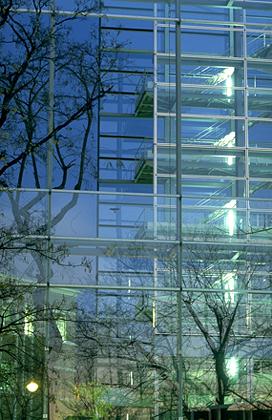The desert
dal 19/6/2000 al 5/11/2000
Segnalato da
Arnoux
Antonio Beato
Félix Bonfils
Gaëtan Gatian de Clérambault
Jules Gervais-Courtellemont
Charles de Foucauld
Émile Fréchon
Francis Frith
John B. Greene
Jules Imbert
Lehnert & Landrock
José Ortiz-Echagüe
J. Pascal Sebah
Félix Teynard
Sir Wilfred Thesiger
Zangaki
Hergé
Michael Light
Walter De Maria
Antoine de Saint-Éxupéry
Bill Viola
Lara Baladi
Balthasar Burkhard
Raymond Depardon
William Eggleston
Lee Friedlander
Yervant Gianikian
Angela Ricci Lucchi
Titouan Lamazou
Andrei Ujica
Beat Streuli
19/6/2000
The desert
Fondation Cartier, Paris

Confronting 19th century images with contemporary experiences of the desert
and of space, the exhibition the desert is essentially organised around a group of
photographs and films, for the most part new works and special commissions.
Performing a leap in time, from adventurer-photographers of the 19th century to
contemporary artists, this exhibition is distinguished by a chronological or
panoramic vision and reveals the desert as landscape, as degree zero and the
very essence of landscape.
Offering the image of a place that appears to be unaffected by time, and from
before Time, a landscape from the beginning of the world, the desert is
fundamentally bound to creation.
In an extraordinary coincidence, 19th century Europe discovered the desert,
through the experience of the great travellers, scientific missions organised for
archaeological or geographical purposes, the development and the taste for
Egyptology, simultaneous with the invention of photography. The latter introduced
the image of the desert to Europe; solitary travellers or members of scientific
expeditions, artists and photographers embarked on the depiction of the desert
as a territory to explore and as a landscape. The desert revealed to Europe the
idea of a vast expanse, of immensity. It was the unfolding concept of space itself.
Looking at a series of unpublished photographs by pioneers of the genre, such as
Maxime du Camp, John B. Greene, Félix Teynard, Emile Fréchon, Francis Frith,
and artists from the first few decades of the 20th century, like Lehnert & Landrock
or Edward Weston, the images of veiled women by Gaétan Gatian de
Clérambault, with their undulating white robes, provide a metaphorical
counterpoint to the landscapes of dunes, furrowed by the wind.
Emphasising the duality of the desert as a place of contrasts, both fascinating
and hostile, formed of stability and movement, simultaneously " desert distress,
desert tenderness " to quote Raymond Depardon, the exhibition will compare at
this historic moment some contemporary experiences of the desert regions.
Through works like those of Michael Ashkin, who endeavours to represent the
immensity of the desert in his enormous models, these ideas appear as
reflections on space, on the experience of a new space, at an age when the
limits of space are continually pushed out, to the point of disappearing, of
vanishing altogether.
With a few special orders, the Fondation Cartier has invited several artists, such
as Raymond Depardon with Titouan Lamazou, or Lee Friedlander, to travel and to
extend their experience of the desert.
A place full of light, where the horizon vanishes, where any visual reference is
missing, the desert is also a place to explore the limits of the image, through the
tricks of perception known as mirages, thermal manipulations of reality that make
imaginary landscapes appear. Bill Viola's film shot in the Chott El Djerid is a
response to Dali's pictorial vision of mirages, or the characters of Hergé. Altering
our sense of space, turning our understanding of dimensions and of the scale of
things upside down, questioning the very notion of perspective, the desert also
transforms all perception of time.
A place of individual experience, the desert is also a place to come face to face
with oneself. Beyond any metaphysical aspect, this exploration of one's own
limits has a spiritual resonance. The Desert exhibition will thus be an opportunity
to pay tribute to Wilfred Thesiger, adventurer, explorer, humanist and author of
Desert of deserts - the 20th century masterpiece of the genre - through a
collection of unpublished photographs.
Thus, organised around a series of works that evoke the desert as landscape,
this exhibition will address, in particular, the way in which photography, since its
invention, has portrayed the desert, and how the cinema, backed up by video,
shows it. With this collection of photographs and films, the exhibition will come
alive and open up different concepts of space.
Old photography
Arnoux, Antonio Beato, Félix Bonfils, Gaëtan Gatian de Clérambault, Jules
Gervais-Courtellemont, Charles de Foucauld, Émile Fréchon, Francis Frith, John
B. Greene, Jules Imbert, Lehnert & Landrock, José Ortiz-Echagüe, J. Pascal
Sebah, Félix Teynard, Sir Wilfred Thesiger, Zangaki
Modern and contemporary works
Hergé, Michael Light, Walter De Maria, Antoine de Saint-Éxupéry, Bill Viola
Works Commissioned by the Fondation Cartier
Lara Baladi, Balthasar Burkhard, Raymond Depardon, William Eggleston, Lee
Friedlander, Yervant Gianikian et Angela Ricci Lucchi, Titouan Lamazou, Andrei
Ujica (montage made from images by Pier Paolo Pasolini), Beat Streuli
Opening for the press June 20, 2000
Visitors' information, tel. 33 1 42 18 56 51
Exhibitions
Every day, except Monday, from 12 am to 8 pm
Entrance fee: 30frs
Reduced rate: 20 frs (students, under 25s, old-age pensioners and Amis des Musées
card-holders)
Free admission (not including Nomadic Nights): Circle of Friends, under 10s, ICOMs
and the unemployed
Fondation Cartier pour l'art contemporain
261, boulevard Raspail
75014 Paris
Metro : Raspail or Denfert-Rochereau
Bus : 38, 68, 91;
RER : Denfert-Rochereau
Telephone : 33 1 42 18 56 51
Facsimile : 33 1 42 18 56 52
Opening hours
The Fondation Cartier pour l'art contemporain is open to the public every day except Mondays,
from 12 am to 8 pm.
Entrance fee : 30 frs. Reduced rate : 20 frs (students, under 25s, old-age pensioners and Amis
des Musées card-holders)
Free admission (not including Nomadic Nights) : under 10s, ICOMs and the unemployed.
Group visits
By appointment only
Guided visits round the exhibitions daily
Information : 33 1 42 18 56 67
Press Information
Linda Chenit
Tel. 01 42 18 56 77
Fax. 01 42 18 56 52



